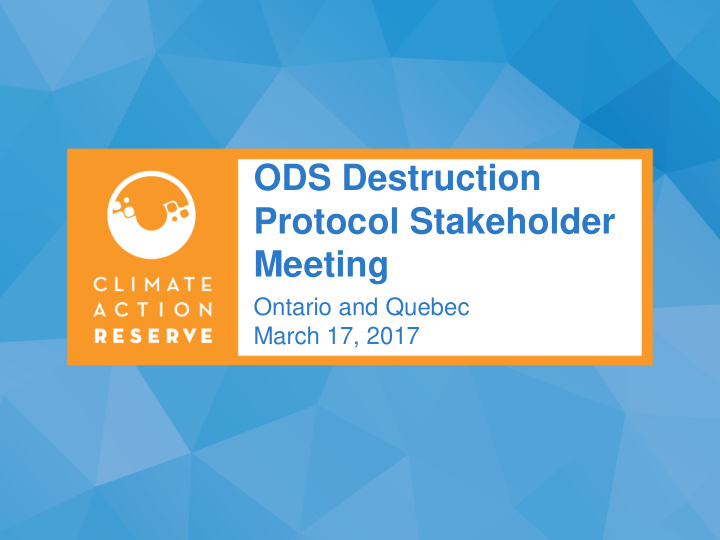



ODS Destruction Protocol Stakeholder Meeting Ontario and Quebec March 17, 2017
Agenda 1. Process update 2. Issues for discussion 3. Protocol changes 4. Audience questions 5. Next steps 2
Item 1 PROCESS UPDATE 3
Process update Timeline Task January PAT works with Ministries to develop task teams and coordinate outreach. Initial meeting of the TTT. Staff from the Reserve present the draft protocol and any proposed February 17 changes. TTT members are asked to submit feedback and comments. February 22 TTT comments are due to the Reserve. Feb 23 – Mar 3 PAT will revise the protocol based on TTT comments. Initial meeting (webinar) with the broader group of interested stakeholders. TTT members are March 3 encouraged to attend this meeting, as well. March 9 Stakeholder & TTT comments due March 9-14 PAT will revise the protocol based on stakeholder and TTT comments Second meeting (webinar) with the stakeholder group, including TTT members, March 17 to discuss the revised protocol March 24 Stakeholder &TTT comments due March 27 – PAT will revise the protocol based on stakeholder and TTT comments April 4 April 13 Final, revised protocol will be submitted to the Ministry for approval TBD MOECC and MDDELCC will conduct formal public comment periods 4
Item 2 ISSUES FOR DISCUSSION 5
Protocols vs regulations • Several comments were related to regulatory policies at the Ministry level – This protocol adaptation is not the forum in which those policies are being considered – Any regulatory policy comments should be directed to MOECC and/or MDDELCC 6
HFC blowing agents • Need additional information to calculate the baseline landfill emission factor – Percent of Remaining Blowing Agent Released During Anaerobic Conditions – After shredding and compacting, how much BA is released from the remaining particles of foam? • Reserve will continue to pursue this information 7
Refrigerant HCFC-22 • Stakeholder suggestion to expand eligible refrigerant list to include HCFC-22 • Virgin material still imported until 2020 – Eligibility would require that the equipment be taken out of service or retrofitted for a different chemical – Ministries must still confirm that they are comfortable with this • Need data to determine baseline leak rates and substitute emission rates – Not included in previous US EPA Vintaging Model data • Reserve will continue to pursue this information 8
Protocol name • Name change proposed – “Halocarbon Destruction Project Protocol” • Awaiting results of research to include HFC blowing agents 9
Item 3 PROTOCOL CHANGES 10
Minor changes • Minor language reorganization and clarification throughout the document • Addressed some typos and missing elements noted by TTT and Stakeholders • Removal of content where it was redundant with other sections • Added Glossary of Terms to be consistent with other protocols 11
Project location & duration • Projects may now involve multiple destruction facilities – Site visit requirement applies to all destruction facilities – Documentation must be very clear about which material went to which facility • Projects may include up to 5 years of destruction events – Annual reporting still applies 12
Unused material • Allow for eligibility of unused refrigerant • Must document the following: 1. Testing results to show that the material meets or exceeds the AHRI-700 standard for that particular chemical; and, 2. Evidence linking the material and the container to its original manufacturer. 13
Relaxed chain of custody • Still require Point of Origin details • Must document all facilities between POO and destruction – Relaxed requirements for paperwork along the way 14
Verification site visits • Removed requirement for “one additional project facility” • Required site visits: – Destruction facilities – Mixing facilities (where applicable) – Appliance foam and refrigerant extraction facility (where applicable) 15
Item 4 AUDIENCE QUESTIONS 16
Item 5 NEXT STEPS 17
Submit comments • Stakeholder Team to review draft protocol and submit comments to the Reserve no later than: – Friday, March 24, 2017 (end of day) – max@climateactionreserve.org • Microsoft Word document, organized by protocol section • Any comments related to the regulation should be directed to the appropriate Ministry 18
Further Stakeholder Engagement • PAT will work with TTT on any further revisions • Depending on significance of revisions, another Stakeholder webinar may be scheduled • Stakeholders will be e-mailed if an additional webinar is scheduled 19
Contact Information Stephen Holle Max DuBuisson Program Associate & LFG Director of Policy & LFG Secondary Contact Adaptation Lead sholle@climateactionreserve.org max@climateactionreserve.org (213) 542-0297 (213) 785-1233 All documents posted here: http://www.climateactionreserve.org/ozone-depleting-substances- capture-and-destruction/ 20
Recommend
More recommend